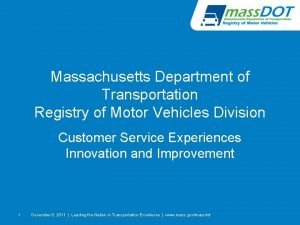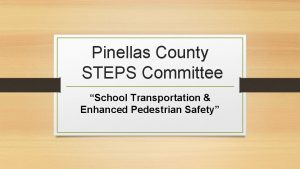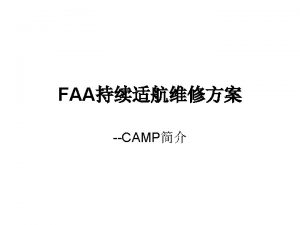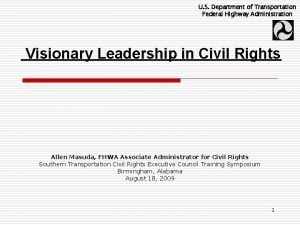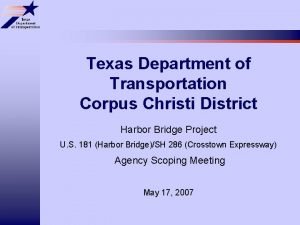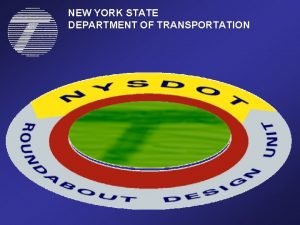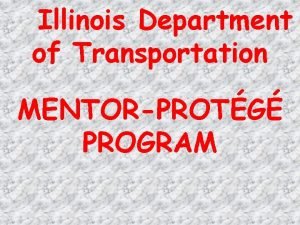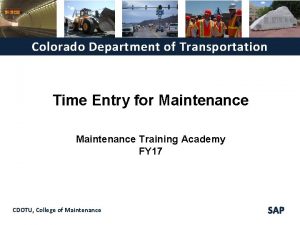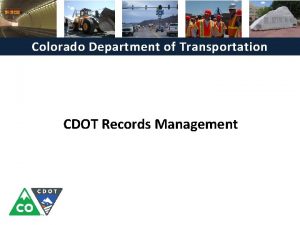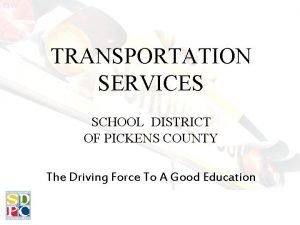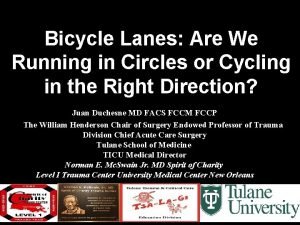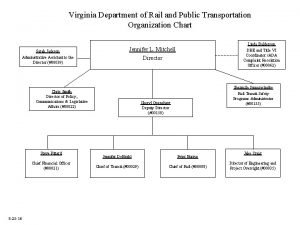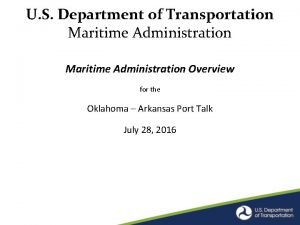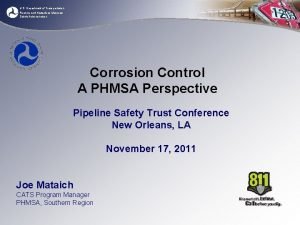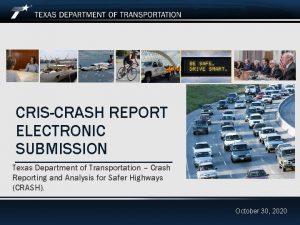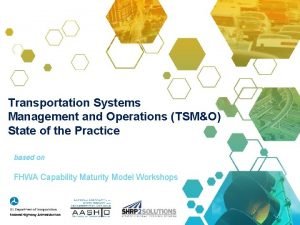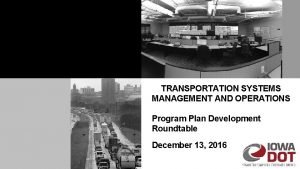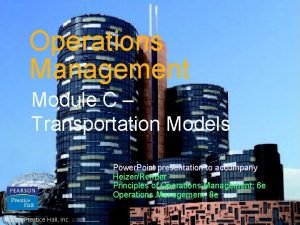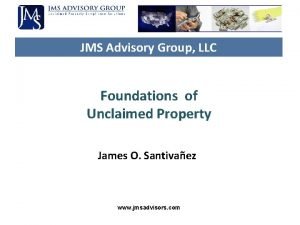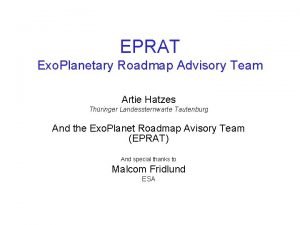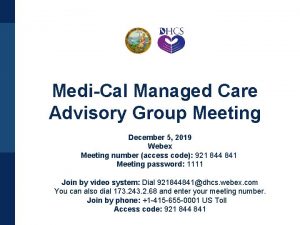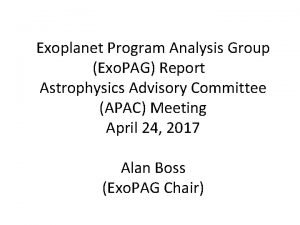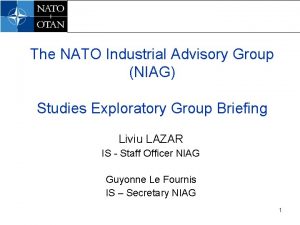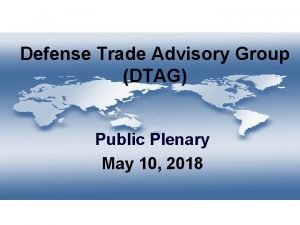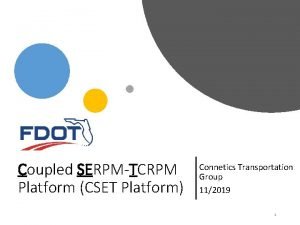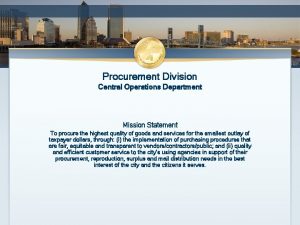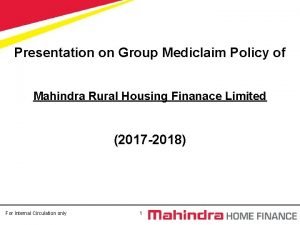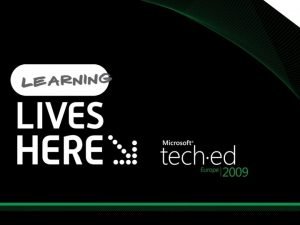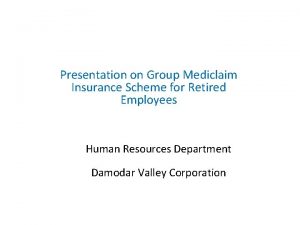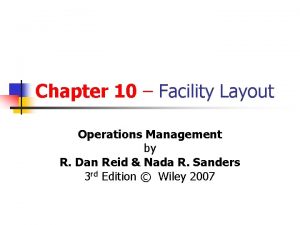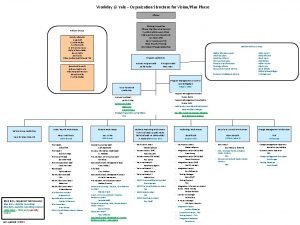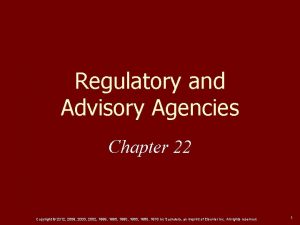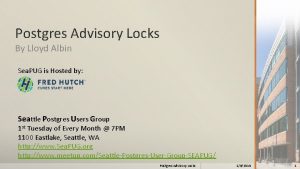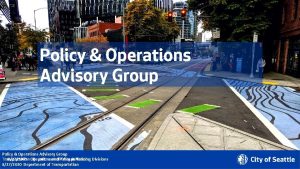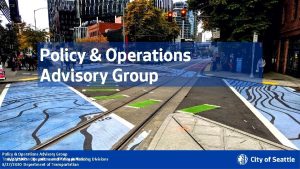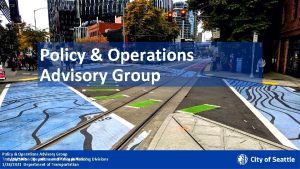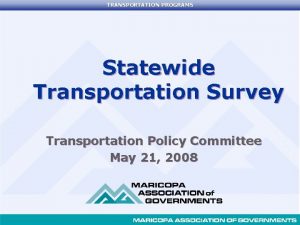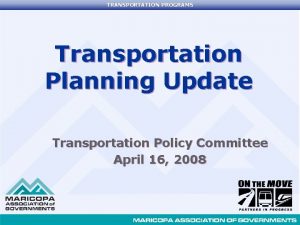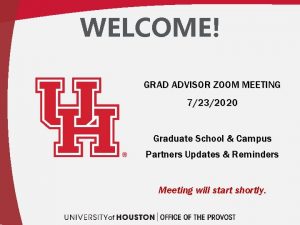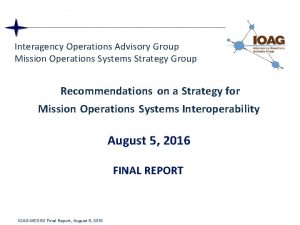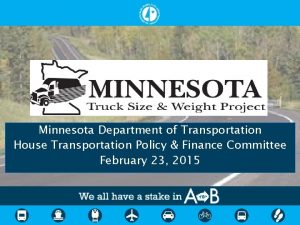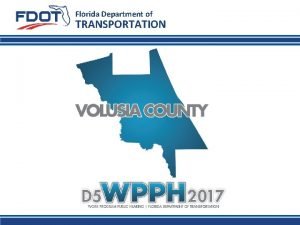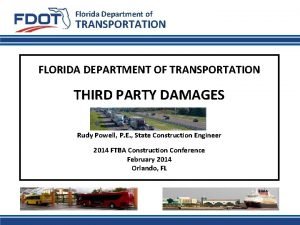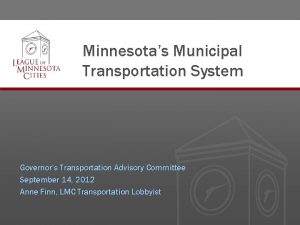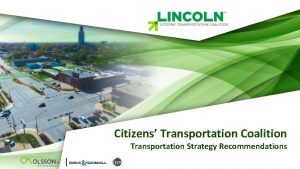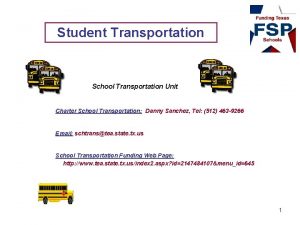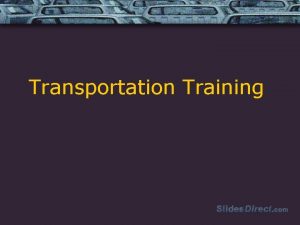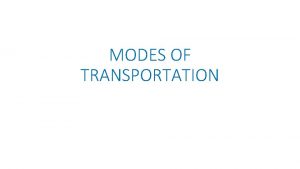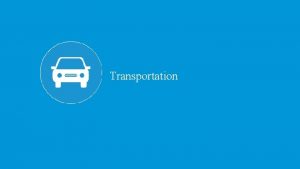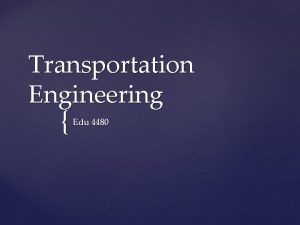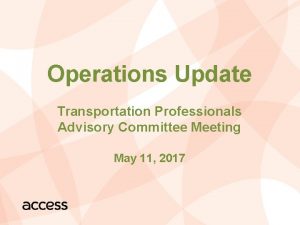Policy Operations Advisory Group 7232020 Department of Transportation













































- Slides: 45

Policy & Operations Advisory Group 7/23/2020 Department of Transportation Operations and Policy & Planning Divisions 7/23/2020 Department of Transportation

Meeting overview 1. Re-introductions 2. Signals Operations • Recap of Introduction to Signals Operation • Pedestrian Signal Policy – key components and opportunity to discuss 3. Introduction to Modal Integration 4. Wrap-up and next steps 7/23/2020 Department of Transportation 2

Meeting format § We want to hear from you; we encourage you to chime in and participate § During presentations: § We will screenshare slides § Please stay on mute § If you want to chime in or have quick questions answered as we go, please use the chat function (send to "all participants" or "all panelists") or raise hand function § Please say your name before you speak § If you are having technical difficulties, please use the chat or email ellie. smith@seattle. gov 7/23/2020 Department of Transportation 3

Re-Introductions § Name § Organization you represent § 20 second question: §Name one life experience that helped shape your interest in transportation. 7/23/2020 Department of Transportation 4

POAG roster Board, Committee, or Commission Members Bike Advisory Board Alexander Lew and Pierre Brunelle Business Improvement Association Mike Stewart (Ballard) Freight Advisory Board Warren Aakervik and Geri Poor Pedestrian Access Advisory Committee Dorene Cornwell and Steven Feher Pedestrian Advisory Board David Seater and Anna Zivarts Planning Commission David Goldberg and Grace Kim Transit Advisory Board Erin Tighe and Bryce Kolton Transportation Equity Workgroup Kiana Parker and Yordanos Teferi 7/23/2020 Department of Transportation 5

Recap: Introduction to Signal Operations Regulating the flow of people and goods in one of the nation's fastest growing cities 7/23/2020 Department of Transportation 6

Recap: types of signal operations Adaptive Signals respond in real time to detected changes in traffic conditions. Coordinated Signals are timed with respect to other signals in a corridor or network. Isolated Signals operate alone and do not consider other intersections. 7/23/2020 Department of Transportation 7

Recap: signals introduction Pedestrian timing • Walk and flashing don't walk Pedestrian actuation • Push button is activated Cycle length • Time to serve each movement at a signal 7/23/2020 Department of Transportation 8 Types of signal phasing • Protected • Permitted • Pedestrian • Bike • Transit

Recap: signal operation trade-offs Operational Changes Vehicle and transit delay Adding Phases Increase thru delay Reduce turning delay Increasing pedestrian crossing time Could increase Adding pedestrian recall Increase Reducing cycle lengths Increase congestion and queueing Pedestrian & bike Increased delay Increase delay on main Increases as a result of Reduces ped/bike wait street. No change cycle length times on side street Pedestrian accessibility Reduces conflicts Improves access Conflicts Reduced conflicts between vehicles and No change pedestrians and bikes 7/23/2020 Department of Transportation 9 Improves expectations Increases access Potential increase in red light running and jaywalking Potential increase in collisions due to congestion

12 th Ave & Yesler Way Current conditions: • Two phases with permitted left-turns • Pedestrian recall • Bike lanes and streetcar on Yesler Way • Near an elementary school • High collision location • No space for left-turn pockets on Yesler Way • Streetcar and traffic in same lanes • Closely spaced signals 7/23/2020 Department of Transportation 10

12 th Ave & Yesler Way Potential signal operation: 1. Protect eastbound and westbound left-turns 2. Maintain permissive leftturn phase and install leading pedestrian and bike intervals 3. Restrict eastbound and westbound left-turns 7/23/2020 Department of Transportation 11

12 th Ave & Yesler Way trade-offs Trade-offs (from existing) Protected left-turns Leading bike and pedestrian interval Restrict left-turns Transit delay Increased ~50 sec per cycle Slightly Increase ~5 sec per cycle Reduced ~15 sec per cycle Pedestrian & bike delay Increased ~30 - 40 sec per cycle Maintained Conflicts Reduced (No EB/WB left turn conflicts) Slightly Reduced (peds and bikes get a head start) Reduced (No EB/WB left-turn conflicts) Maintained Reduced (215 WB left-turns in peak hour) Vehicle access Maintained 7/23/2020 Department of Transportation 12

Traffic Signal Operations Policy Update Purpose, policy guidance, and implementation 7/23/2020 Department of Transportation 13

Purpose & objectives Purpose Objectives • Develop consistent policies for signal operation city wide • Establish a unified policy on traffic signal timing and actuation • Support mobility and access while minimizing delay to pedestrians • Respond to City Council Resolution 31909 • Develop policies around improved pedestrian access • Provide direction for signal engineers and practitioners to be consistent • Implement equitably and based on data • Consistent implementation based on land use 7/23/2020 Department of Transportation 14

Policy components 1. Define maximum cycle length 2. Increase pedestrian crossing time 7/23/2020 Department of Transportation 15 3. Pedestrian actuation (push buttons) 4. Implement policy

1. Maximum cycle length • Cycle length is the time required to complete one entire sequence of signal indications for all movements • Our typical cycle lengths range from 60 to 120 seconds 7/23/2020 Department of Transportation 16

Cycle length key factors • Width of intersections and pedestrian crossing time • Number of protected movements and separate phases • Multiple phase intersections typically require long cycle lengths • Two phase intersections can usually run short cycle lengths 7/23/2020 Department of Transportation 17

Cycle length policy Proposed SDOT CYCLE LENGTH POLICY: • No greater than 100 seconds in urban centers • No greater than 180 seconds in manufacturing/industrial centers • In all other locations: • No greater than 120 second along minor and collector arterials • No greater than 150 seconds along principal arterials Goal: maintain shorter cycle lengths as feasible while allowing us flexibility to respond to incidents and events that may require special timing 7/23/2020 Department of Transportation 18

Revisiting Rainier Ave S (S Kenny St to 52 nd Ave S): • • Minimum cycle length: 76 seconds Actual cycle length: 90 and 45 seconds most of the day, 100 and 50 seconds in PM peak • 6 intersections run 90 and 100 • 7 intersections run 45 and 50 Trade off: running a longer cycle at some intersections allows a much shorter cycle at others, reducing transit impact along Rainier. 7/23/2020 Department of Transportation 19

Additional trade-offs and discussion • Reduced wait time for people walking and biking across the main street • Reduced wait time for side streets and left-turns • Potential for increased queueing for left-turns • Potential increased delay for transit and freight along some corridors • Potential increased delay for people walking and biking along the main street 7/23/2020 Department of Transportation 20

2. Pedestrian crossing time 7/23/2020 Department of Transportation 21

Pedestrian crossing time policy Pedestrian timing consists of: • Walk: interval a pedestrian can start crossing the street • Pedestrian Clearance: interval for a person to cross the street SDOT PEDESTRIAN TIMING POLICY: Pedestrians will get more time to cross all streets • Walk is 7 seconds or greater (current practice) • Pedestrian Clearance calculated based on a walking speed of 3 ft/sec • MUTCD standard is 3. 5 ft/sec • Walking speed of 2. 5 ft/sec will be used based on community request 7/23/2020 Department of Transportation 22

Pedestrian crossing time: example Using current walking speed Using new walking speed Left turns 12 seconds Fairview Ave N 42 seconds 51 seconds Mercer St 32 seconds 38 seconds Minimum cycle length 98 seconds 113 seconds Trade-off: giving more time for pedestrians to cross the street will result in more pedestrian wait time 7/23/2020 Department of Transportation 23

Additional trade-offs and discussion • Improved accessibility for all pedestrians • Longer cycle lengths, especially at large or complicated intersections • Less time for people to legally step off the curb to begin crossing • More time allocated to the side street • Additional delay along arterials 7/23/2020 Department of Transportation 24

3. Pedestrian actuation Pedestrian recall: walk phase comes up without pushing push button Actuated pedestrian: push button needs to be pushed for walk phase Type Pedestrian Operation All pedestrian movements Total Recall automatically served (pre-timed) Partial Recall (semiactuated) No Recall (fully actuated) Pedestrian movement along main street served automatically Pedestrian movement across main street requires pedestrian detection All pedestrian movements require pedestrian detection Pedestrian movement across No Recall main street requires (pedestrian detection half‑signal) 7/23/2020 Department of Transportation 25 Vehicle Operation All or most vehicle movements automatically served for a set amount of time. Main street vehicle movement served automatically Side street vehicle movement requires vehicle detection All vehicle movements require vehicle detection Main street vehicle movement served automatically Side street vehicle traffic controlled by stop sign

Pedestrian actuation policy Proposed/Draft SDOT PEDESTRIAN ACTUATION POLICY: • Provide total pedestrian recall at all intersections within Urban Centers and Hub Urban Villages unless unfeasible given intersection characteristics • Excludes pedestrian only signals and phases • Use data to determine if signal should be actuated or in recall at all other location • Pedestrian recall will be provided along the main street at the majority of intersections 7/23/2020 Department of Transportation 26

Pedestrian actuation • • Signals in Urban Centers and Hub Urban Villages account for roughly 50% percent of the city's signals As part of COVID-19 response, we have begun implementing this policy and have added recall to over 150 additional signals in these areas (about 80% of signals now have total pedestrian recall) 7/23/2020 Department of Transportation 27

Pedestrian actuation – additional thresholds Additional thresholds for installing pedestrian recall to be determined based on study: 7/23/2020 Department of Transportation 28 • Push buttons are actuated during 50% of cycles for the majority of the day • Push buttons are actuated during 75% of the cycles during the peak hours • Pedestrians volumes exceed 100 per hour for at least 4 hours a day • Adjacent to a school, pedestrian volumes exceed 50 per hour for at least 2 hours a day • Vehicle green time used for the associated vehicle phase, is within 5 seconds of the minimum needed pedestrian time

Pedestrian actuation example 5 th Ave S and S Dearborn St/Seattle Blvd S All crossings are in pedestrian recall except west crossing, with low pedestrian volumes - 8 per hour Ped timing for west crosswalk: walk = 11 FDW = 27 Total = 38 seconds There are heavy transit volumes in other directions 7/23/2020 Department of Transportation 29

Additional trade-offs and discussion • Prioritized pedestrian access and mobility in Urban Center and Hub Urban villages • Provides more predictable operations for pedestrians • Potential increase in travel time for all users traveling along main street • Limits ability to run shorter cycle lengths at some intersections • Allows for flexibility and data driven installation Citywide 7/23/2020 Department of Transportation 30

4. Policy implementation Implement these policies when: • Install a new signal • Modify an existing signal • Re-time an existing corridor • Receive a community request 7/23/2020 Department of Transportation 31

Introduction to Modal Integration 7/23/2020 Department of Transportation 32

Modal integration: current policy needs § Provide policy guidance to offer clarity on competing modal priorities, particularly on constrained corridors § Establish a connection between modal priority within our modal plans and operations 7/23/2020 Department of Transportation 33

Modal integration: present challenges • Right-of-way (ROW) allocation challenges • Layered modal plans sometimes ask streets to do too much • Missing "modes”: clarifying how autos and new mobility devices fit in our ROW • Tensions between modal priorities and other essential functions of the ROW, especially parking • Lack of transparency, especially publicly, around our ROW allocation process • Operational challenges • Lack of clarity in our operational objectives for each street • Role of vehicular level of service (LOS) in decision making 7/23/2020 Department of Transportation 34

Existing policy framework Policies • Comprehensive Plan • Complete Streets Ordinance • Race and Social Justice Initiative Design standards and guidance • Streets Illustrated • Metro Route Facilities Guidelines 7/23/2020 Department of Transportation 35 Plans • Modal Master Plans • Other studies including operational, subarea, corridor, street concept plans, and Bicycle-Pedestrian Safety Analysis Processes • Project Roadmap • Complete Streets Assessment • Complete Streets Steering Committee

Comprehensive Plan • T 2. 5 Prioritize mobility needs in the street travelway based on safety and … the modal plan networks (p. 75) • T 2. 8 Not every function can fit in every street. […] Two or more streets can combine to serve as a “complete corridor, ” since not every street can accommodate every need (p. 76) • T 2. 9 Develop a decisionmaking framework to direct the planning, design, and optimization of street right-ofway (p. 77) 7/23/2020 Department of Transportation 36

Comprehensive Plan • Establishes: • 3 zones • 6 essential functions • Prioritizes flex zone functions Figure 3. Flex zone priorities by predominant area land use 7/23/2020 Department of Transportation 37

Comprehensive Plan: 6 functions of ROW 7/23/2020 Department of Transportation 38

Modal Master Plans • Pedestrian (2017) • Priority investment network (PIN) • Freight (2016) • Major and minor routes • Transit (2016) • Frequent transit network (FTN) • Priority bus corridors • Principle, major, minor routes • Bicycle (2014) • Citywide network and local connectors 7/23/2020 Department of Transportation 39

Modal Master Plans: network maps Bicycle Network Map Freight Network Map 7/23/2020 Department of Transportation 40 Frequent Transit Network Pedestrian Priority Investment Network

Streets Illustrated • Establishes • 12 street typologies • Dimensional standards • Deviation request process • Design guidance • Existing ROW deficiencies • Pedestrian realm • Curb-to-curb • Building face-to-building face Urban Village Main Street 7/23/2020 Department of Transportation 41

Streets Illustrated 7/23/2020 Department of Transportation 42

Modal integration approach Collect background information and identify problem Analyze street geometry & networks Develop policy guidance Racial Equity Toolkit process 7/23/2020 Department of Transportation 43 Develop operational targets Draft policies and processes

Next steps #1 – June 25 § Kick-off § Introduction to signal operations #2 – July 23 § Draft Comprehensive Traffic Signal Operations Policy: presentation and discussion § Modal Integration: introduction #3 – August 27 § Draft Comprehensive Traffic Signal Operations Policy: continued discussion § Modal Integration: analysis #4 – Sept 24 § Modal Integration: draft policy options #5 – Oct 22 § Modal Integration: draft policy options and operational priority #6 – date TBD § Modal Integration: policy recommendations and discussion § Wrap-up and reflections 7/23/2020 Department of Transportation 44

Questions? ellie. smith@seattle. gov | (206) 300 -1690 www. seattle. gov/transportation 7/23/2020 Department of Transportation 45
 Massachusetts department of transportation
Massachusetts department of transportation Montana department of transportation
Montana department of transportation Pcsb transportation
Pcsb transportation Department of transportation
Department of transportation Department of transportation
Department of transportation Maricopa county department of transportation
Maricopa county department of transportation Texas department of transportation corpus christi
Texas department of transportation corpus christi Latham traffic circle
Latham traffic circle Department of transportation
Department of transportation Seminole transportation
Seminole transportation Department of transportation
Department of transportation Department of transportation
Department of transportation Pickens county bus office phone number
Pickens county bus office phone number Department of transportation
Department of transportation Virginia department of rail and public transportation
Virginia department of rail and public transportation Us department of transportation maritime administration
Us department of transportation maritime administration Phmsa okc
Phmsa okc Cris txdot
Cris txdot Transportation systems management and operations
Transportation systems management and operations Transportation systems management and operations
Transportation systems management and operations Transportation model operations management
Transportation model operations management Unclaimed property dormancy period matrix
Unclaimed property dormancy period matrix Eprat get
Eprat get Xx2021x
Xx2021x Advisory expert group on national accounts
Advisory expert group on national accounts Exo advisory group
Exo advisory group Niag nato
Niag nato Candace goforth
Candace goforth Connetics transportation group
Connetics transportation group Operations department mission statement
Operations department mission statement Group mediclaim policy presentation
Group mediclaim policy presentation Admx migrator tool
Admx migrator tool Gpo
Gpo Microsoft desktop optimization pack 2018 download
Microsoft desktop optimization pack 2018 download Dvc pensioner medical card
Dvc pensioner medical card System group windows
System group windows Pacific health policy group
Pacific health policy group Group technology advantages
Group technology advantages A hybrid layout combines
A hybrid layout combines Work day yale
Work day yale Wealth advisory solutions
Wealth advisory solutions Ppp advisory
Ppp advisory Implement change management with these six steps
Implement change management with these six steps Chapter 22 regulatory and advisory agencies
Chapter 22 regulatory and advisory agencies Nasa astrophysics advisory committee
Nasa astrophysics advisory committee Lloyd albin
Lloyd albin
